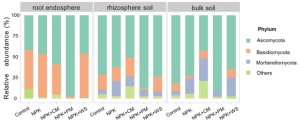A group from State Key Laboratory of Soil and Sustainable Agriculture, Institute of Soil Science, Chinese Academy of Sciences, Nanjing, China, etc. has reported about changes in belowground fungal flora in wheat field under long-term fertilization.
<a href=”https://pubmed.ncbi.nlm.nih.gov/35266812/”>https://pubmed.ncbi.nlm.nih.gov/35266812/</a>
In this paper, new findings are reported from a long-running fertilization experiment in wheat field (more than 35 years) covering the following conditions: NPK fertilizer, NPK and cow manure (NPK+CM), NPK and pig manure (NPK+PM), NPK and wheat straw (NPK+WS), and no fertilizer (Control).
At the phylum level, Ascomycota, Basidiomycota, and Mortierellomycota dominated the fungal community, irrespective of the treatments and habitats, together accounting for over 80% of the total sequences obtained. Compared with the other treatments, NPK+PM treatment had the highest relative abundance of Ascomycota (96.9%, 87.1%, and 91.1% in root endosphere, rhizosphere soil, and bulk soil, respectively)
Then, the correlation between alpha diversity and physiochemical variables (such as Total P, Total C, Total N, Total K, P, Ca, Mg, Na, Fe, Mn etc.) was analyzed. The random forest analysis revealed that phosphorus and Zn always were the best predictors of diversity changes in root endosphere, rhizosphere soil, and bulk soil. There were significant correlations between phosphorus and alpha diversity in root endosphere, and between Zn and alpha diversity in rhizosphere soil and bulk soil. The higher the P and Zn concentration, the lower the alpha diversity in rhizosphere fungi.
This can be considered as follows. Pig manure had higher phosphorus content than cow pig manure and after adding pig manure, the phosphorus content of soils and wheat roots was significantly higher than that of cow manure addition. Hence, long-term fertilization, especially pig manure application, can supply adequate and readily accessible phosphorus and phosphorus-like nutrients across soil to roots, which may lessen the dependence of crops on microbiota, thereby lessening total fungal diversity probably. Similar to phosphorus, it is reasonable to link the competition for resources and survival among fungal communities to Zn-induced changes in fungal diversity.

